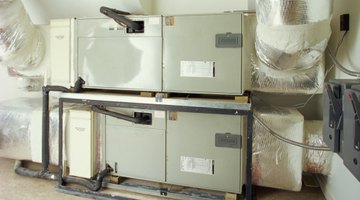How to Bend Copper Pipe Without Kinks for an Air Conditioner
Kinks in an air-conditioning system's copper pipe restrict refrigerant flow, which reduces system efficiency and can reduce the compressor's life expectancy. Typically, air-conditioning systems use soft copper piping, which comes from the manufacturer in 25- to 100-foot rolls.

Rolled copper limits the amount of leak-prone braised fittings, but it requires custom bended turns. Kinks occur when a technician attempts to bend the pipe in too tight of a radius or by applying too much pressure in a small area.
-
Select a tubing bender with the correct sized bending die. The label on the die's side indicates its size. Hand-held tubing benders have a two handles that hinge around a bending die. Clamps mount to the handles near the bender's pivot point. The bending die mounts to the pivot point. Bending dies use a valley-shaped channel that holds the copper pipe. The valley's width must match the refrigerant piping's exterior size.
-
Open the tubing bender's handles to the full open position. In the full open position the clamps will align above the die.
-
Slip the copper pipe into the tubing bender's clamps. The pipe slides over the top of the die and into the open slot on the side of the clamp.
-
Position the pipe in the valley. The mark on the top of the bending die represents the apex of the bend. Move the copper pipe until the desired center of the bend aligns with the die's mark.
-
Squeeze the tubing bender's handles together. Stop squeezing once the pipe's bend has reached the desired angle.
-
Open the tubing bender's handles. Remove the tubing.
The Drip Cap
- Kinks in an air-conditioning system's copper pipe restrict refrigerant flow, which reduces system efficiency and can reduce the compressor's life expectancy.
- Rolled copper limits the amount of leak-prone braised fittings, but it requires custom bended turns.
- The bending die mounts to the pivot point.
- The mark on the top of the bending die represents the apex of the bend.
- Open the tubing bender's handles.
References
Resources
Writer Bio
Based out of Central Florida, Robert Sylvus has been writing how-to and outdoor sports articles for various online publications since 2008. Sylvus has been a home improvement contractor since 1992. He is a certified HVAC universal technician.
Photo Credits
- Comstock Images/Comstock/Getty Images
- Comstock Images/Comstock/Getty Images
More Articles



